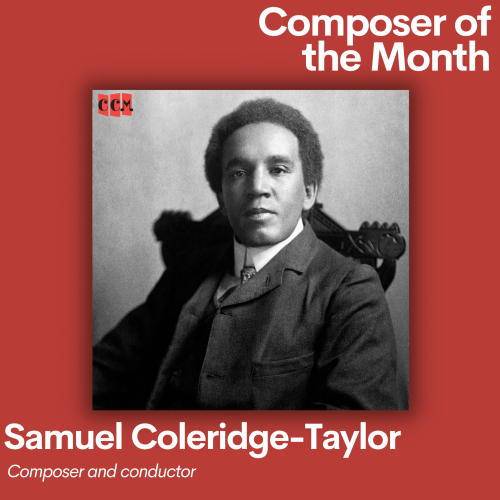August 2, 2023
Samuel Coleridge-Taylor: August Composer of the Month

As we continue to explore the fascinating world of music history, certain composers really stand out. They leave a lasting impact that continues to shape our appreciation for music. This August, we are focusing on one such influential figure in classical music – Samuel Coleridge-Taylor.
Coleridge-Taylor’s Early Life
Samuel Coleridge-Taylor was born in London in 1875 to an English mother and a father from Sierra Leone. He grew up with his mother as the main parent-figure and she nurtured his love for music. However, his grandfather recognized his musical abilities and purchased his first violin for him. By the age of fifteen, Coleridge-Taylor earned a scholarship to the prestigious Royal College of Music.
Coleridge-Taylor’s Career
During his time at the Royal College, Coleridge-Taylor studied under the renowned composer Charles Villiers Stanford. Stanford recognized his pupil’s talent early on and encouraged him to specifically focus on composition. Evidently, this guidance proved pivotal in Coleridge-Taylor’s career, leading him to compose his first acknowledged work, “Piano Quintet in G minor,” at just 18 years of age.
Coleridge-Taylor’s pinnacle moment came with his choral work “Hiawatha’s Wedding Feast.” This piece premiered in 1898 and was an instant triumph. This catapulted him to fame and led to international tours, including three visits to the United States, where he conducted his works with leading orchestras.
During his career, Coleridge-Taylor faced racial prejudice, but he never let it deter him. Alternatively, he used his platform to challenge and overcome these societal barriers, garnering the respect and admiration of his contemporaries and future generations.
Music and Legacy
Coleridge-Taylor’s music masterfully intertwines elements of Western classical music and African melodies. His compositions resonate with a distinct rhythmic vitality and melodic richness that echo his dual heritage.
Moreover, his magnum opus, “Hiawatha’s Wedding Feast,” is a testament to his brilliant compositional skills. It’s an enchanting blend of Romantic-era harmony with a libretto based on Henry Wadsworth Longfellow’s epic poem “The Song of Hiawatha.” The use of flowing melodies, choral harmonies, and colorful orchestration in this work demonstrate his profound understanding of musical drama.
However, to focus only on this would be to neglect other remarkable works like “Symphony in A minor,” “24 Negro Melodies,” and “Violin Concerto in G minor.” Each piece showcases a different facet of his compositional genius. For example, the “Violin Concerto in G minor” brims with romantic lyricism, showcasing the violin’s expressive range. Additionally, “24 Negro Melodies” explores African melodies in a profound display of his cultural pride.
A Final Note
Samuel Coleridge-Taylor’s life and work are a testament to his indomitable spirit, talent, and the limitless power of music. His unique blending of Western classical music and African influences left an enduring legacy, earning him a rightful place amongst the greatest composers.
Though he died at the young age of 37, Coleridge-Taylor left behind a diverse body of work that continues to resonate with audiences. As we celebrate his life this month, we invite you to explore his works to discover the profound emotional depth and rich cultural history in each composition.

